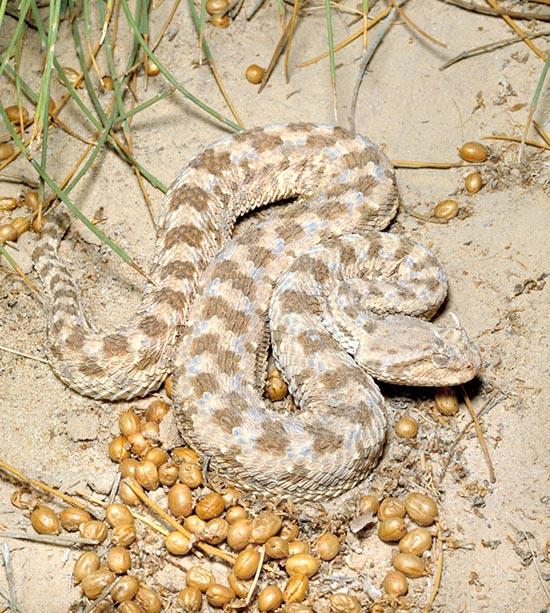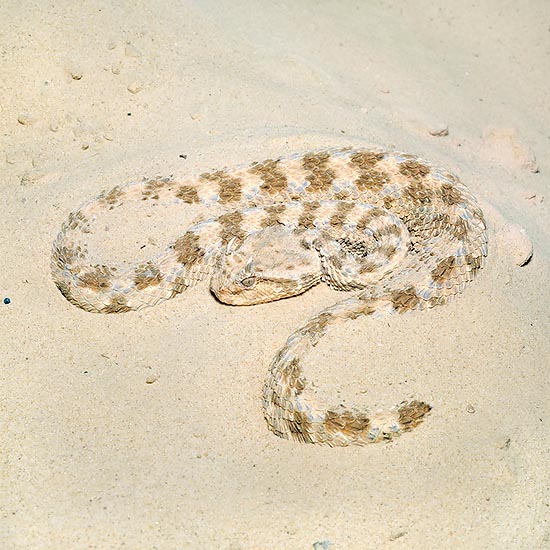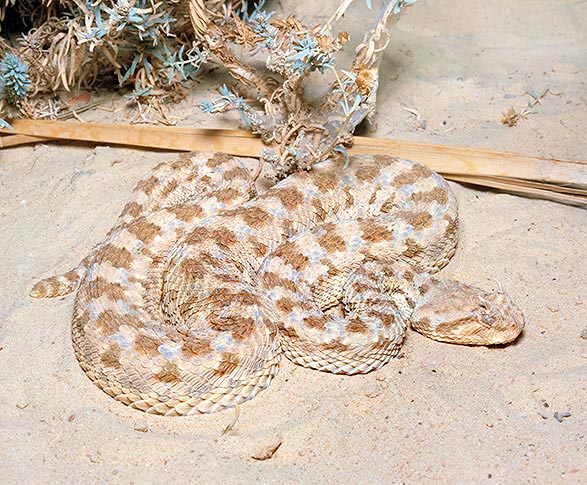Family : Viperidae

Text © Dr. Gianni Olivo

English translation by Mario Beltramini

The Desert horned viper (Cerastes cerastes) lives in North Africa © Giuseppe Mazza
The Cerastes forms a genus of viperids of medium-small size, typical of Northern Africa, Middle East, Arabian Peninsula, Israel, Iran and Iraq.
Although the name cerastes (coming from the old Greek and referring to the presence of “small horns) means, rightly, horned, not all the members of the genus are equipped with these typical outgrowths placed over the eyes, being these modified scales, present only in Cerastes cerastes and Cerastes gasperetti.
It seems, therefore, that such characteristic is typical of species living in sandy zones, whilst those colonizing rocky or stony areas do not have it.
The Saharan horned viper (Cerastes cerastes is a species present in Northern Africa, from Morocco and Mauritania up to Egypt and the northern part of Sudan, in the Arabian Peninsula, partly in Israel and Jordan, whilst the Cerastes gasperetti goes from the Arabian Peninsula to Iran and Iraq.
The typical habitat is the sandy, sub-desert or frankly desert one, but individuals may be found also in rocky areas, with scattered bushes and up to 1.500 m of altitude above sea level.
The Saharan horned viper has, all over the Saharan Africa, a sinister reputation, only partly justified, and is very much feared by some desert populations, more, at times, than other viperids which are, in realty, more dangerous, due to their size, their strength and amount of inoculated venom (Moorish viper Macrovipera mauritanica).
As a matter of fact, the cerastes are of relatively modest dimensions, usually around the 50 cm, even there are reports of almost 90 cm specimens. But, primarily, the venom, even if dangerous, does not cause a high number of deaths, even if a bite of this serpent is often to be deemed as potentially fatal.
The Cerastes cerastes has a rather thick and stocky body, with a well distinguishable tail and covered by highly keeled scales, bigger and with a slight depression on the spine, smaller, but always keeled, on the sides. The ventral scales have a lateral keel which helps the animal in moving on soft grounds like the sandy dunes, where it usually adopts the “side-winding” gait.
As it happens in the echis (see text), when upset, it may rub the highly keeled scales, by scraping the spires together in an endless series of undulations, thus producing a menacing, hissing or crackling, sound. This may be heard even when the animal is not alarmed, but is effecting the movements for burying in the sand. The head is flattened and triangular, wide and with short and wide buccal opening; the neck appears, proportionally, narrow and this makes evident the passage between head and body.
The eyes, placed much forward and slightly bent upwards, have an elliptic pupil, vertically placed, of an average size and are surmounted by the typical “small horns”, single modified cephalic scales, elongated and pointed, on whose signification and function much has been discussed, however, there are reports about specimens where these typical small horns are replaced by simple superciliary arched “canopies”.

It loves silting, leaving out only part of the head or the eyes © Giuseppe Mazza
One of the assumptions is that the small horns are useful for interrupting the profile of the upper portion of the head, contributing to the camouflage; another one, which I do not full agree with, is that they may be a sort of protection against the sand and the sun.
The nares, rather evident, open upwards, position which suggests a vocation for the sandy soils, where this reptilian loves to bury, gradually and regularly sinking, thanks to small movements of the spires which shift the sand laterally.
When the animal is in such a way silted, leaving out only part of the head, or even only the eyes, small horns and nares, it is extremely well camouflaged and practically impossible to be sighted. This characteristic stands at the base of the great fear nourished for this viper by the Saharan nomadic peoples, because, indeed, for those walking barefooted on the sand, especially during the night hours or after the sunset, to place inadvertently the foot on a cerastes is not at all a nice or healthy experience.
The silting through that typical vibrating movement which does not leave any trace on the soil, is useful for the animal also for ambushing, but it looks like that even the mating may occur under the sand surface, phenomenon often observed in the specimens held in captivity.
Also the colour is extremely suitable for camouflaging the reptilian in its habitat, as it varies from the pale grey to the beige, often with small darker small dots, but there are individuals with a more reddish colour, and, on the spine, are often evident small darker dots with a rectangular shape. Mainly nocturnal animal, it spends the warm hours under the sand, often at the shade of a rock or a bush, but it also willingly utilizes abandoned holes and dens or cracks in the rocks, as, like all reptilians, it fears the excessive heat at least as much as the cold, being not equipped with an efficient system of thermoregulation.
The movements, while on the move, are usually quite slow, however the speed of the head, when it bites, is like a lightning and the reptilian entrusts its own safety more to the stillness and the camouflage than to the agility. The temper, even if it is not an animal attacking without provocation, is somewhat nervous and irascible and it does not hesitate in biting if disturbed, even if its bite does not always inoculate venom.
The reproduction is oviparous and the female lays from 8 to 24 eggs, which will open after 60-80 days. The newborns are from 10 to 14 cm long by the time of the hatching.
The venom of the Cerastes cerastes is rather complex and contains active principles with different actions. Next to the phenomena of platelet aggregation and activation of the prothrombin and of the X factor of the coagulation (procoagulant activity), there are substances with opposite action, anticoagulant and haemorrhagic besides a phosphodiesterase.

Due to its camouflage the incidents are frequent, but usually the bite is not fatal © Giuseppe Mazza
At least 12 toxins have been identified in the venom of the horned viper and the symptomatology includes: even impressive swelling and edema, due to the increased capillary permeability and the cytotoxic action which may cause necrosis and gangrene, haemolytic anemia and even acute renal failure which may cause the death of the bitten person.
Anyhow, the known instances of human demises are not numerous and also the old Egyptians did consider the bite of the cerastes as curable and usually not fatal.
This makes us think that, if the legend of Cleopatra is true, the queen would have much unlikely chosen a viper for committing suicide and bye sure would have opted for the cobra (Naja haje), first of all because endowed with a much more powerful venom and also because its neurotoxic venom would have given her a surely less painful and less antiaesthetic death than that of a viperid.
The Egyptian doctors, in fact, had already written in 2200 BC, for instance, on a papyrus, now kept in a museum, the bite of a cerastes might be treated with the pharmacopoeia of that time, but probably such “curability” was due more to the fact that its bite is rarely enough lethal for an adult man than to the therapies of the time.
An interesting data concerning the venom of this reptilian is that relevant to the studies done on its possible utilization in the cancers treatment.
Many venoms of serpent have been analyzed for such purpose, from those of various cobras to that of Trimeresurus flavoviridis, which proved to be capable to inhibit the growth of the cancer cells of the mouse sarcoma, of the melanoma and of the HCC, at least “in vitro”. Later on (in 2003), a study carried on the venom of the Egyptian cerastes, proved that some of its fractions had a strong killer activity on the cancer cells in vitro.
Much is still to be done in the study of the venoms of serpent which, like many other venoms, in the proper doses or in selecting only some fractions of them, may transform in drugs to fight deadly diseases, but the difficulties of such utilization stand not so much in the poor availability or complexity of the venoms, but in the poor homogeneity of the same, seen that different specimens of the same species or populations simply separated geographically, may show differences of composition and of active mechanism even remarkable.
Common names : English: Desert horned adder; French: Vipère à cornes; German: Wüsten-Hornviper; Local names: Lefaa, Zus, Takelt.
→ For general notions about Serpentes please click here.
→ To appreciate the biodiversity within the SNAKES please click here.
